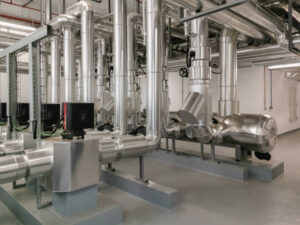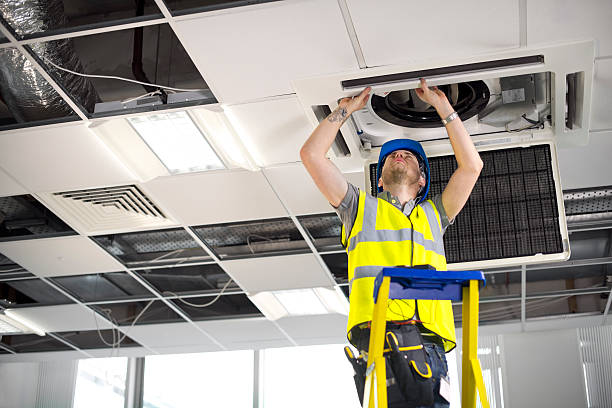HVAC systems might often be overshadowed by more immediate home improvements, but their role is unparalleled in ensuring comfort and efficiency in our living and working spaces. They bring a unique blend of functionality and innovation that sets them apart in the vast world of building management and maintenance, offering a distinct experience that distinguishes HVAC as an essential component in modern structures. Key types of HVAC systems include Central Systems, Forced Air Systems, Hydronic Systems, Split Systems, Mini-Split Systems, Multi-Split Systems, and Ductless Systems, each known for their specific applications and benefits.
Single Unit Systems stand out for their compactness and suitability for smaller spaces or specific rooms, offering a tailored but effective choice for temperature control. Digging a bit deeper, each type of HVAC system presents its own set of features, installation methods, energy efficiency considerations, and maintenance requirements. The following sections will explore these aspects in detail, providing a richer understanding of what makes HVAC systems a critical and valued technology in homes and businesses worldwide.
What is HVAC?

HVAC stands for Heating, Ventilation, and Air Conditioning. It’s a system that makes our homes and buildings comfortable to live and work in. HVAC does this by controlling the indoor climate and air quality.
This means it can warm or cool the air, bring in fresh air from outside, and remove unwanted moisture, odors, and airborne contaminants. By doing these things, HVAC systems help keep the temperature just right, ensure the air we breathe is clean, and even save energy, making them an essential part of modern living and working environments.
Essential HVAC Components
At the heart of every HVAC system are key components that ensure it runs smoothly and efficiently. These include the thermostat, which controls the temperature settings; the furnace, providing heat; the air conditioner, which cools and dehumidifies; and the ductwork, circulating air throughout the building. Each part plays a crucial role in maintaining comfort and air quality indoors.
The thermostat acts as the system’s command center, the furnace and air conditioner work to adjust the indoor climate, and the ductwork distributes the conditioned air evenly. Understanding these components is vital for anyone looking to maintain or improve their HVAC system.
Why is HVAC important in buildings

HVAC systems play a pivotal role in buildings for several reasons. Firstly, they regulate indoor temperature, making spaces comfortable regardless of the weather outside. Secondly, they improve air quality by filtering out pollutants and circulating fresh air, which is crucial for health.
Lastly, HVAC systems contribute to energy efficiency by using technology that reduces power consumption, saving money and helping the environment. Together, these benefits highlight why HVAC is indispensable in modern construction, ensuring buildings are not only comfortable but also safe and sustainable.
Comfort: Regulating indoor temperature
HVAC systems keep the indoor temperature just right, whether it’s hot or cold outside. This means homes and offices stay comfortable all year round.
Air Quality: Filtering and circulating air
By filtering out pollutants and bringing in fresh air, HVAC systems ensure the air inside buildings is clean and safe to breathe.
Energy Efficiency: Reducing power consumption
Modern HVAC systems use less energy to heat and cool buildings. This not only saves money but also helps protect the environment by using resources wisely.
How does HVAC work?
HVAC systems work by using a combination of heating, ventilation, and air conditioning to control the indoor environment. Heating components like furnaces or heat pumps warm up the air during cold weather. Ventilation processes exchange indoor air with outdoor air, ensuring that air quality is maintained by removing pollutants and moisture.
Air conditioning units cool down the air when it’s hot outside, removing humidity to make indoor spaces comfortable. Together, these functions make HVAC systems essential for creating a pleasant and healthy indoor climate in both residential and commercial buildings.
Heating: Warming indoor spaces
Heating systems like furnaces and heat pumps keep buildings warm. They work by heating air and circulating it throughout the space.
Furnaces
Furnaces generate heat by burning fuel or using electricity. They’re a common choice for cold climates.
Heat Pumps
Heat pumps pull heat from the air or ground outside and move it indoors. They can also cool spaces by reversing the process.
Ventilation: Exchanging and filtering indoor air
Ventilation systems bring in fresh air and remove stale, contaminated air. They help maintain good air quality.
Natural Ventilation
Natural ventilation uses doors, windows, and vents to allow fresh air in and push old air out without mechanical help.
Mechanical Ventilation
Mechanical ventilation systems use fans and ducts to actively control indoor air quality by filtering and exchanging air.
Air Conditioning: Removing heat and humidity
Air conditioners cool and dehumidify air, making indoor environments more comfortable in hot weather.
Central Air Conditioners
Central air conditioners cool entire buildings through a network of ducts and are controlled by a single thermostat.
Room Air Conditioners
Room air conditioners are smaller units designed to cool a single room or a small area, offering a more localized solution.
Related Reading: HOW DOES HVAC WORK: UNVEILING THE SECRETS OF COMFORT AND AIR QUALITY
Types of HVAC systems

HVAC systems come in various types to suit different needs and spaces. Central Systems are designed to heat and cool entire buildings through a network of ducts. Forced Air Systems use a blower to circulate air through ducts, providing both heating and cooling.
Hydronic Systems, on the other hand, use water to heat spaces, circulating it through pipes to radiators or baseboard heaters. Split Systems have separate units for heating and cooling, offering flexibility in installation and use. Mini-Split Systems and Multi-Split Systems are ductless, making them ideal for spaces where ductwork isn’t feasible.
Lastly, Ductless Systems provide a versatile option for adding heating or cooling to specific rooms without the need for extensive ductwork, perfect for small spaces, additions, or specific rooms that require individual temperature control. Each type of HVAC system offers unique benefits, making it important to choose the right one based on the specific requirements of the space and the occupants’ needs.
Central Systems: Single unit for heating and cooling
Central Systems manage both heating and cooling from a single unit, distributing air through ductwork. This setup is efficient for entire buildings.
Forced Air Systems
Forced Air Systems use a blower to move air through ducts, providing quick and effective heating or cooling across different spaces.
Hydronic Systems
Hydronic Systems heat rooms by circulating hot water through pipes to radiators or underfloor heating systems, offering a comfortable warmth.
Split Systems: Separate units for heating and cooling
Split Systems have distinct units for heating and cooling, allowing for more flexible installation and energy-efficient operation.
Mini-Split Systems
Mini-Split Systems are ductless, making them ideal for retrofitting in spaces without existing ductwork and for targeting specific areas.
Multi-Split Systems
Multi-Split Systems connect multiple indoor units to a single outdoor unit, offering individual temperature control in different rooms without ducts.
Ductless Systems: No ductwork is required
Ductless Systems provide heating and cooling solutions directly to specific areas, perfect for homes without traditional ductwork.
For small spaces
Ductless and mini-split systems are especially suited for small spaces where installing ductwork is impractical or too expensive.
For additions or specific rooms
These systems offer an efficient way to extend heating and cooling to new additions or rooms that were previously without.
Related Reading: CENTRAL AIR CONDITIONER TYPES: FIND THE PERFECT FIT FOR YOUR HOME OR BUSINESS
Key components of an HVAC system
The efficiency and performance of an HVAC system hinge on its key components: the thermostat, furnace, air conditioner, and ductwork. The thermostat is the control center, allowing users to set and adjust the temperature according to their comfort. The furnace heats the air, which is then distributed throughout the building via the ductwork.
For cooling, the air conditioner takes over, removing heat and humidity from indoor air. The ductwork plays a crucial role in both heating and cooling, as it circulates the conditioned air to every part of the building. Together, these components work in harmony to maintain the desired indoor climate, ensuring both comfort and air quality.
Thermostat: Controls temperature settings
The thermostat is the brain of the HVAC system, allowing users to set and adjust indoor temperatures to their comfort level.
Furnace: Provides heat
A furnace heats air and circulates it throughout the building to keep you warm during colder months.
Gas Furnaces
Gas furnaces use natural gas to heat the air, known for their efficiency and cost-effectiveness in colder climates.
Electric Furnaces
Electric furnaces heat air using electricity, preferred for their simplicity and lower initial installation costs.
Air Conditioner: Cools and dehumidifies
The air conditioner removes heat and humidity from the air, cooling down the indoor environment during hot weather.
SEER Rating importance
The SEER Rating measures the efficiency of an air conditioner, with higher ratings indicating better energy efficiency and lower utility bills.
Ductwork: Circulates air throughout the building
Ductwork is a network of tubes that transports heated or cooled air to different parts of a building, ensuring even distribution.
Materials used
Ducts can be made from a variety of materials, including sheet metal, fiberglass, or flexible plastic, each affecting the system’s efficiency and cost.
Design considerations
Effective ductwork design is crucial for efficient airflow and temperature control, requiring careful planning to avoid energy loss and ensure comfort.
Maintenance tips for HVAC systems

Keeping an HVAC system in top condition is key to ensuring its efficiency and longevity. Regular filter changes, ideally every 1-3 months, prevent dust and debris from clogging the system, maintaining air quality and reducing wear on components. Seasonal inspections before the heating and cooling seasons start can catch and fix small issues before they turn into bigger problems.
Additionally, an annual professional tune-up by a technician can optimize the system’s performance, ensuring it runs smoothly and efficiently throughout the year. These maintenance steps are essential for keeping the HVAC system working effectively, saving money on energy bills, and providing a comfortable indoor environment.
Regular Filter Changes: Every 1-3 months
Changing the filters in your HVAC system every 1-3 months keeps the air clean and prevents the system from working too hard, which can save energy and extend the system’s life.
Seasonal Inspections: Before the heating and cooling seasons
Having your HVAC system inspected before the start of the heating and cooling seasons can identify and fix any potential issues, ensuring your system runs efficiently when you need it most.
Professional Tune-ups: Annual check-ups by a technician
An annual tune-up by a professional technician can keep your HVAC system running at peak performance. This includes checking for leaks, assessing airflow, and making sure all parts are in good working order.
Final Thoughts
Understanding HVAC basics is crucial for maintaining a comfortable and healthy indoor environment. By familiarizing yourself with the components and types of HVAC systems, you can make informed decisions that enhance energy efficiency and air quality. Regular maintenance ensures your system operates smoothly, saving you money and extending its lifespan.
Take control of your indoor climate today by scheduling a professional HVAC inspection today with Callidus Air. Call us now!

